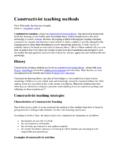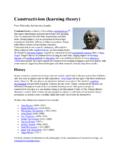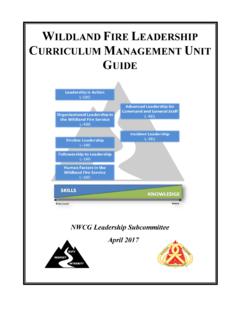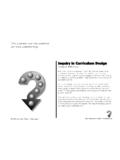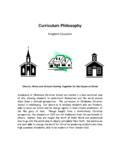Transcription of SECONDARY SCHOOL GRADE 7 Information …
1 MINISTRY OF EDUCATION SECONDARY SCHOOL GRADE 7 Information Technology curriculum guide CONTENTS Preface ..i ii Acknowledgements ..iii Content Rationale for GRADE 7 Information Technology curriculum Introduction to IT Lab: Rules, Health and Safety Guidelines .. 1 Protection and Care of Computer Systems .. 3 Introduction to Hardware: Components of the Computer System .. 4 Introduction to Operating 7 Keyboard and Mouse Skills Development .. 8 Introduction to Word Processing .. 9 Accessing the Intranet .. 10 History, Present, and Future of Computers: Research.
2 12 Educational Tours to Commercial and Industrial Businesses .. 12 Introduction to 13 Compilation and Review of all Terms Introduced in GRADE 7 .. 16 i PREFACE Information Technology curriculum Guides, Grades 7 to 11, were produced in 1999. These curriculum Guides (draft) were designed to make all students computer literate and allow teachers to use the computer as a tool for teaching any subject of the SCHOOL curriculum . The documents covered three major aspects of Information Technology: (i) Information Technology Theory, (ii) Word Processing, and (iii) Spread Sheet.
3 The Guyana Education Access Project (GEAP) with the help of the SECONDARY SCHOOL Reform Project (SSRP) and the National Centre for Educational Resource Development (NCERD) have collaborated to supervise the revision of the draft IT curriculum Guides produced in 1999. Since these Guides have been in use for more than three years, it is imperative to update them and keep them within the new developments that have since occurred. Other key contributors in the revision process were a number of GEAP trained Information Technology Administrators (ITAs) taken from Regions 6 and 10.
4 These ITAs are still teachers of Information Technology in SECONDARY Schools and Schools with Primary Tops. The Objectives of the Revised National Information Technology Guides are to: 1. guide the teaching of Information Technology in schools. 2. Help teachers improve their Information Technology skills. 3. Help to prepare students for Information Technology at the Caribbean Examination Council (CXC) and Caribbean Advanced Proficiency Examination (CAPE). 4. Serve as a tool for students who choose not to write IT CXC or CAPE but need to have a working knowledge of IT for the world of work.
5 Ingrid Barker Head (ag) curriculum Development and Implementation Unit (CDIU) National Centre for educational Resource Development (NCERD) March 2003 ii INTRODUCTION It is our understanding that Information Technology requires immediate practical application on a computer in order to ensure a student s understanding and retention of the material. Without quality time spent practicing on a computer, a student cannot be qualified as literate in Information Technology. This curriculum guide has been developed based on this understanding and encourages those educational professionals who choose to institute the IT curriculum in their schools to have adequate computer facilities to do so.
6 For example, if your SCHOOL does not have power and/or computer labs, then you do not have to institute the IT curriculum . If on the other hand, your SCHOOL does have computers, you might consider the following suggestions for integrating IT into the SCHOOL curriculum with a limited number of computers: Administrative Uses Teachers could be encouraged or required to use word-processing, spreadsheet, and educational software to develop their lesson plans, type up their class lists, keep their students grades and attendance records, and submit all their other administrative work to the Headmaster or Principal.
7 This would allow for the development of a solid foundation of basic IT skills among the teaching staff and perhaps later contribute to the full integration of IT into regular subject areas or the eventual implementation of the IT curriculum at the SCHOOL . Teaching Teachers could use the computers as a presentation and demonstration tool to teach another subject or to show how a practitioner of that field ( Scientist, Mathematician, Social Scientist, Artist, Academic, Poet, Writer, etc.) would use the computer to solve a particular problem, complete research, or achieve their objective.
8 Word-processing Students could be encouraged or required to type up and submit their SCHOOL assignments using word-processing software available on the computer. Spreadsheet Students could be encouraged or required to create tables, graphs, and complete their Maths or Science assignments or supplement their research assignments with capabilities available on spreadsheet software. Educational Software Students could be encouraged or required to use encyclopaedias, typing programs, and other educational software to supplement and complete their assignments from other subjects.
9 In these cases, the computers would be made available on a timetable basis to teachers and students who have been given a basic introduction to the facilities and their care and maintenance. The IT curriculum guide should be used as a guide only. It should not be adhered to slavishly if it is inappropriate for the technical and human resources available to the SCHOOL . If the entire curriculum cannot be covered in the course of a year, then it is up to the instructor to determine the most important topics for review. iii ACKNOWLEDGEMENTS The Ministry of Education is grateful to the following persons whose tireless work has resulted in the production of this revised Information Technology GRADE 7 curriculum guide .
10 Alan Wood, IT Teacher, Bartica SECONDARY SCHOOL , Voluntary Services Overseas Camille Caesar, Deputy Headmistress (ag), St. Aidan s Primary SCHOOL Gem Carryl, Assistant Mistress, Wismar Hill Primary SCHOOL Gomattie Dubaria, IT Lecturer, Cyril Potter College of Education, Rose Hall Kim Spencer, IT Teacher Trainer, Guyana Education Access Project Leonie Peters, Assistant Mistress, Wisburg SECONDARY SCHOOL Loralina Roberts, Assistant Mistress, Linden Foundation SECONDARY SCHOOL Marlon Pearson, Assistant Master, Wismar Christianburg Multilaterial SCHOOL Mona Campbell, Assistant Mistress, St.

